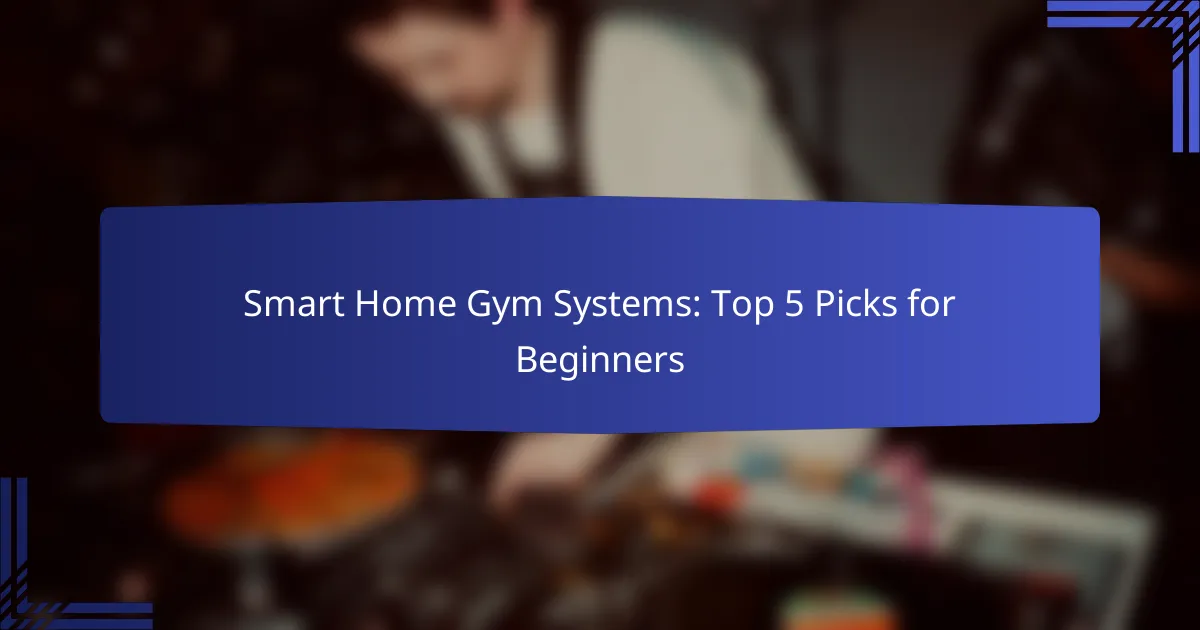Smart home gym systems are an excellent choice for beginners looking to embark on their fitness journey. Combining ease of use with interactive features, these systems provide guided workouts and real-time feedback, all while fitting seamlessly into small spaces. With personalized training options and a variety of workouts, they make it easier to stay motivated and achieve your fitness goals.

What are the best smart home gym systems for beginners?
The best smart home gym systems for beginners combine ease of use, interactive features, and a variety of workout options. These systems typically include guided workouts, real-time feedback, and are designed to fit in small spaces, making them ideal for those new to fitness.
Tonal Smart Home Gym
Tonal is a wall-mounted gym system that offers digital weights and personalized coaching. It uses electromagnetic resistance, allowing users to adjust weight easily and track their progress through an app. This system is particularly beneficial for strength training, offering a wide range of exercises.
Beginners should consider the space required for installation and the subscription fees for access to workout programs. Tonal’s compact design makes it suitable for small areas, but the initial investment can be significant, typically in the low thousands of USD.
Mirror Home Gym
The Mirror is an interactive fitness device that looks like a regular mirror but transforms into a screen for live and on-demand classes. It offers a variety of workouts, including yoga, strength training, and cardio, making it versatile for beginners.
When using the Mirror, beginners can benefit from the visual feedback and motivation from instructors. However, the cost can be high, often exceeding a thousand USD, plus a monthly subscription fee for classes. It’s essential to ensure you have enough wall space for installation.
Tempo Studio
Tempo Studio combines a smart mirror with a weight set and a camera that tracks your form. It provides personalized feedback and adjusts workouts based on your performance, making it suitable for beginners looking to improve their technique.
With a focus on strength training, Tempo offers a range of classes and equipment. The investment is typically in the mid-thousands of USD, which includes the equipment and access to classes. Beginners should be aware of the space needed for the setup and the importance of following the guided instructions for safety.
NordicTrack Vault
The NordicTrack Vault is a smart gym that features a storage cabinet for weights and accessories, along with a screen for streaming workouts. It offers a variety of fitness classes, including strength, yoga, and HIIT, making it a well-rounded option for beginners.
One of the key advantages is the ability to store equipment neatly, which is ideal for small living spaces. The price range is generally in the low thousands of USD, and users should consider the subscription costs for accessing the workout library.
ProForm Carbon EL
The ProForm Carbon EL is an affordable smart home gym option that includes a variety of workout programs and a compact design. It features a built-in screen for guided workouts and is suitable for beginners who want to explore different fitness styles.
This system is budget-friendly, typically priced in the low hundreds of USD, making it accessible for those just starting. However, users should be aware that the range of features may not be as extensive as higher-end models, so it’s essential to assess your fitness goals before purchasing.

How do smart home gym systems work?
Smart home gym systems integrate technology with fitness equipment to provide personalized workout experiences. They typically use sensors, cameras, and software to deliver interactive training sessions and monitor user performance in real time.
Interactive workout programs
Interactive workout programs offer users a variety of guided exercises tailored to their fitness levels and goals. These programs often include video demonstrations, virtual trainers, and adjustable difficulty settings to keep workouts engaging and effective.
Many systems allow users to choose from different workout styles, such as strength training, cardio, or yoga, ensuring a well-rounded fitness routine. Popular platforms may even feature live classes or on-demand sessions, providing a community feel while exercising at home.
Real-time performance tracking
Real-time performance tracking is a key feature of smart home gym systems, enabling users to monitor their progress during workouts. This technology typically measures metrics such as heart rate, calories burned, and exercise form, helping users stay informed and motivated.
Some systems provide instant feedback, allowing users to adjust their intensity or technique on the fly. This data can be invaluable for setting goals and tracking improvements over time, making it easier to stay committed to fitness journeys.

What are the benefits of using smart home gym systems?
Smart home gym systems offer a range of benefits, including convenience, personalized training, and access to a variety of workouts. These systems integrate technology to enhance your fitness experience, making it easier to stay motivated and achieve your goals.
Convenience of home workouts
The convenience of home workouts is a major advantage of smart gym systems. You can exercise whenever it fits your schedule, eliminating the need to commute to a gym. This flexibility allows you to easily incorporate fitness into your daily routine.
Additionally, many smart home gym systems come with compact designs, making them suitable for smaller living spaces. You can set up a workout area in your living room or spare room without requiring extensive equipment.
Personalized training experiences
Smart home gym systems provide personalized training experiences through tailored workout plans and real-time feedback. Many systems use artificial intelligence to analyze your performance and adjust routines based on your progress, ensuring that you are always challenged and engaged.
Some systems also offer access to virtual trainers and classes, allowing you to choose workouts that match your fitness level and preferences. This customization can significantly enhance your motivation and adherence to a fitness regimen.

What should beginners consider when choosing a smart home gym system?
Beginners should focus on space requirements, budget considerations, and available features when selecting a smart home gym system. Understanding these factors will help ensure that the system fits their lifestyle and fitness goals.
Space requirements
When choosing a smart home gym system, assess the available space in your home. Systems can vary significantly in size, from compact setups that fit in small apartments to larger configurations that require dedicated rooms.
Measure the area where you plan to install the gym system, considering both the equipment’s footprint and the space needed for movement. A good rule of thumb is to allow at least 2-3 feet of clearance around the equipment for safety and comfort.
Budget considerations
Your budget will greatly influence your options for smart home gym systems. Prices can range from a few hundred to several thousand dollars, depending on the brand, features, and included accessories.
Consider not only the initial purchase price but also potential ongoing costs, such as subscription fees for workout programs or maintenance. Setting a clear budget can help narrow down choices and avoid overspending.
Available features
Smart home gym systems come with a variety of features that enhance the workout experience. Look for options that include interactive training sessions, performance tracking, and integration with fitness apps.
Some systems offer personalized workout plans, while others provide live classes or on-demand content. Evaluate which features align with your fitness goals and preferences to ensure you choose a system that keeps you motivated and engaged.

How do smart home gym systems compare in pricing?
Smart home gym systems vary significantly in pricing, typically ranging from a few hundred to several thousand dollars. Factors influencing the cost include equipment features, subscription services, and brand reputation.
Price range of Tonal
Tonal systems generally fall within the price range of approximately $2,995 to $3,995, depending on the package and accessories chosen. This price includes the wall-mounted unit and access to a library of workout programs.
Additionally, users should consider a monthly subscription fee, which is around $49, for access to live and on-demand classes. This ongoing cost can add up, so it’s essential to factor it into your overall budget.
Price range of Mirror
The Mirror typically retails for about $1,495, making it a more affordable option compared to Tonal. This price includes the sleek, full-length mirror that doubles as a display for workouts and classes.
Similar to Tonal, the Mirror requires a subscription for full access to its content, which is approximately $39 per month. This subscription provides a variety of fitness classes and personalized coaching, making it a valuable investment for beginners.
